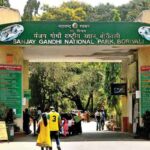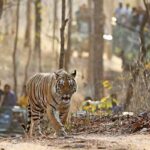Top 5 National Parks In India Nature has gifted India with a diverse range of geographical circumstances, allowing a diverse range of flora and wildlife to thrive. Its distinctive topography, which includes green lush terrains, mountains, dense forests, plains, uneven landscapes, and other features, has resulted in a diverse range of physical and climatic circumstances. The country’s many topographies provide refuge for a large number of species on the verge of extinction, allowing them to live in their native environment.
As a result of major extinctions of wildlife, the country has built a number of wildlife sanctuaries and national parks to encourage the conservation of these species. While India’s first national park, Jim Corbett National Park, opened in 1936, the country only had five national parks until 1970. When the entire population of wild tigers was reduced to only 1800, it came as a shock. In the following two years, the Project Tiger and Wildlife Protection Act was created to govern and grow the tiger population.
With over 100 national parks and 50 tiger reserves, the country has been able to preserve its flora and fauna to an impressive degree, and this process is still underway. With a significant variety of rare wildlife species, the country is now a wildlife tourist hotspot for nature lovers.
The country has been able to preserve its flora and fauna to an astonishing degree, with over 100 national parks and 50 tiger reserves, and this process is currently ongoing. The country is become a wildlife tourist attraction for nature lovers, with a large diversity of uncommon animal species Top 5 National Parks In India.
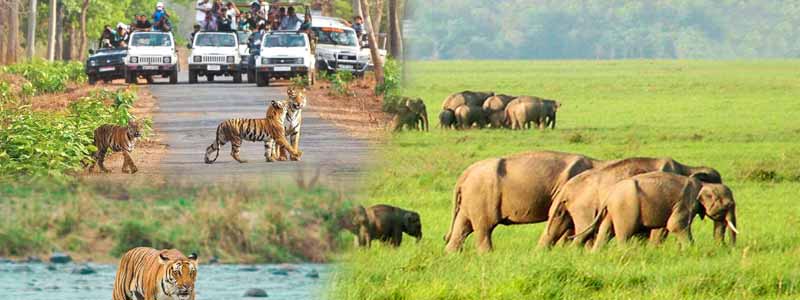
1. Jim Corbett National Park
Jim Corbett National Park is located in the Nainital district of Uttarakhand, which is a perfect destination for nature lovers as well as wildlife lovers. Corbett National Park is one of the first wildlife reserve parks in the country which was established in 1936. Earlier it was named Ramganga National Park, but later the park was named Jim Corbett National Park after the famous hunter-turned-patron Jim Corbett who started Project Tiger, Top 5 National Parks In India.
This national park is one of the nine Tiger Reserves in the country. The park is divided into four different zones – Bijrani, Dhikala, Jhirna and Durgadevi zones. During the peak season, around seventy thousand tourists come from not only the country but from all over the world.
Activities to do:
The park, with about 250 Bengal tigers, 600 elephants, and a good number of golden jackals, barking deer, sambar deer, spotted deer, hog deer, Himalayan black bears, and leopards, is a great place for wildlife viewing. Corbett is divided into 5 different safari zones (Dhikala, Jhirna, Durga Devi, Dhela, and Bijrani) that run safari tours in two shifts (morning and evening). You can choose to take a jeep safari, canter safari, or elephant safari.
Just outside of Corbett Tiger Reserve, a forest reserve zone, Sitabani Buffer Zone, is also open to the visitors of Corbett. It’s well-known for its lush forests, lakes and streams, and ancient temples. You are allowed to take your car inside this zone.
To enjoy wildlife in the Dhikala zone that in fact, is the celebrity among all other zones, you need to stay in Dhikala Forest Rest House.
Apart from wildlife, there are quite many adventure activities like mountain biking, trekking, bird-watching, nature walk, river rafting, and fishing you can take on when in Corbett, Top 5 National Parks In India
If you’ve more time on hand, you can plan to visit the Corbett Museum and Corbett Falls in Kaladhungi that’s just about 45 minutes away from Corbett.
Where to stay
There a good number of stay options in and around the national park. You can choose to stay in a forest lodge or rest house inside the park or can enjoy camping inside the park or book a luxury resort around the park.
We stayed at Jim’s Jungle Retreat on our first trip and at Golden Tusk on our second trip and enjoyed each one of them. Both of them are in the Dhela zone. You must book your safari first, and then choose the accommodation near the zone you’ve booked your safari for.
How to reach
Jin Corbett is about 275 km (6 hours journey) from New Delhi. The best way to reach Corbett from Delhi is by road viz NH9. Alternatively, you can catch a train (Ranikhet Express) from New Delhi to Ramnagar (nearest town) and then hire a local taxi from Ramnagar Railway Station to your resort or rest house.
Best Time to Visit
The best time to visit the park is from December to May. It’s when all the zones are open to the public and the park is at its best.
Entrance Fees
A jeep safari costs INR 4500 (up to 6 persons) for Indian nationals and INR 9000 for foreign nationals while a canter safari costs INR 1750 (each seat) for Indian nationals and INR 3500 for foreign nationals and both of them include Jim Corbett National Park entry fee, pick up and drop from Ramnagar or your resort, and gypsy tariffs.
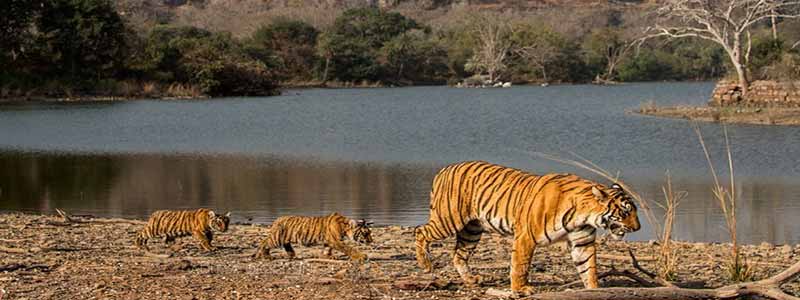
2. Ranthambore National Park
A famous national park in Rajasthan, the Ranthambore National Park is nestled amidst the Aravali and Vindhyan Hills. This national park is a famous abode of Royal Bengal Tigers in the world. Ranthambore has one of the richest flora and fauna. Ranthambore National Park spreads over a sprawling area of 392 sq. km and it is a natural habitat of a variety of exotic species, Top 5 National Parks In India.
Due to the high population of tigers, this tiger reserve is one of the most popular tiger reserves in the world and it is also famous for housing the friendly tigers. The lush green forests, many forms of wildlife and good infrastructure facilities make Ranthambore one of the most sought after wildlife sanctuaries in India. Many foreign, as well as local tourists, regularly throng Ranthambore to spend an exciting vacation here.
Activities to do:
It’s also an excellent national park for bird watching and wildlife safaris. The park is vast, and you could be driving around for ages before spotting tigers, but there are other animals to see along the way such as sambar deer, chital deer, langurs, and marsh crocodiles.
This is one of the best national park in India for safari. Ranthambore National Park has safaris in six-seater jeeps or larger 20-seater canters in 10 zones. Safaris are twice daily in the morning (6.30 am to 10 am) and afternoon (2.30 pm to 6 pm). Book the safaris here.
Besides tiger safaris, Ranthambore is a top destination for bird safaris, and the lakes around the region attract over 300 species of birds such as waterfowls, cormorant, bronzed-winged jacanas, sandpipers, and great-horned owls. Other activities in and around Ranthambore National Park include exploring Ranthambore Fort, Jogi Mahal (former royal hunting lodge) and visiting the Village Women Crafts or the Ranthambore School of Art to admire the work of local artists, Top 5 National Parks In India.
How to reach?
You can get to Ranthambore National Park by train, and the closest railway station is Sawai Madhopur 14 km from the park. Ranthambore is connected by road to major cities of India, and the nearest airport is in Jaipur, 200 km away.
Entrance fees:
The Jeep safari charges are INR 1500 for Indian while INR 2900 for a foreign tourist. The Canter charges are INR 1000 and INR 2300 for foreign national. These charges include the park entry fees as well.
Best time to visit:
The park doesn’t operate during the Monsoon, from 1 July to 30 September. Take a tip and choose zones 1 to 6 for the best chances of spotting tigers.

3. Kaziranga National Park
A UNESCO World Heritage Site, Kaziranga National Park is situated in India’s north-eastern state of Assam, covering the districts of Golaghat and Nagaon. Famous for its conservation efforts, the park is home to two-thirds of the world’s population of the endangered one-horned rhinoceros. This is by far the best national park to visit in India to see the rhinos. It has the highest density of tigers in the world, a significant bird area and breeding ground for Elephants, Asiatic Water Buffaloes and Swamp Deer. Located at the edge of the Eastern Himalayas biodiversity hotspot, the snow-capped peaks of Arunachal Pradesh are also visible from the park.
Activities to do:
Jeep Safari and Elephant Safari facilities are provided by the park authorities. The park is accessible through four circuits- Central Zone, Eastern Zone, Western Zone and Burapahar. Each entrance has its own ticketing counter. Jeep safaris are allowed for all the zones and in two shifts – morning and afternoon. Top 5 National Parks In India, elephant safaris are available only in the Central and Western Zone in two shifts both in the morning. One can opt for boat rides in the Eastern Zone.
How to reach?
By Air: LGBI Airport, Guwahati and Jorhat airport is located about 217 km and 87 km from the park respectively.
By Train: Furkating Railway Junction, about 75 km from Kaziranga is well connected to all the stations of the country.
By Road: The main entrance to the park is through Kohora town, at a distance of 2 km from the National Highway- 37. Local buses and state transport services are also available.
Best time to visit:
November to May. The park remains closed from June to October due to floods.
Entrance fees:
The Kaziranga National Park Entry fee is Rs 100 for Indians and Rs 650 for foreigners.
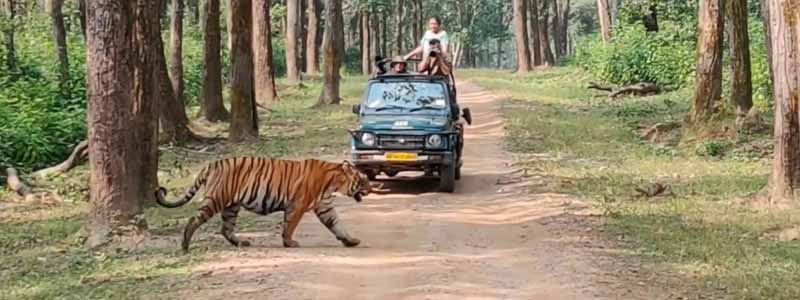
4. Kanha National Park
Kanha National Park is located in the Maikal Range of Satpura in Madhya Pradesh. It is the biggest national park of MP. This national park is famous as Tiger Reserve. It is spread over two districts of Mandla and Kalaghat. This national park was declared a reserve forest in 1879 and subsequently re-evaluated as a wildlife sanctuary in 1933. Later in 1955, it became a Top 5 National Parks In India.
Kanha National Park is the only wild park in the country that is home to a large variety of native species. The place is home to more than 200 species of magical flowering plants and about 70 species of trees. Kanha National Park is an ideal home for a wide range of wildlife species, in addition to powerful tigers harbouring reindeer and countless species of plants, birds, reptiles and insects. The best place here is Bumni Dadar which is also known as the Sunset Point.
Activities to do:
You can only enter the park with a guided safari tour. The best way is to set it up with a safari lodge. I love Pugdundee Safaris, because they do not only offer amazing accommodations, but also send you with well-trained naturalists who take conservation very seriously. You can tell your naturalist if you have special interest in specific animals, so they can take you to the areas in the park, where you are most likely to see them.
How to reach?
Kanha Tiger Reserve is about 4 hours by car from Jabalpur and 3 hours from Gondia. From there, you can book a pickup service with your lodge.
Best time to visit:
Kanha National Park is open from Mid-October to the end of June and closed for the duration of the monsoon.
Entrance fees:
The entrance fee is 6500 for Indian Nationals and 9500 for non-Indians. It includes the entrance fee, a guide fee, jeep rental, and service charge. Tips are always appreciated and you should tip each guide individually.
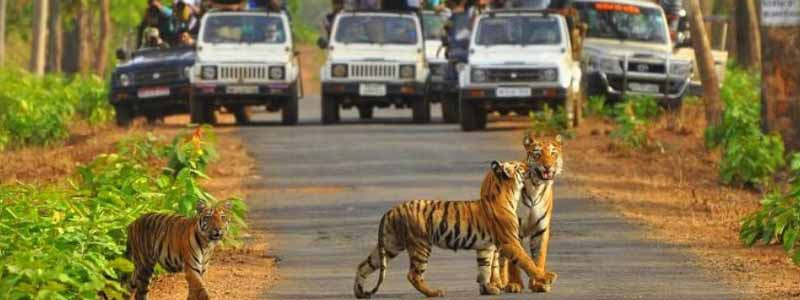
5. Sariska National Park
Sariska National Park is amongst the most visited national parks of the country and is located in the Alwar area of Jaipur, Rajasthan. Situated around 107 kilometers far from Jaipur, this national park covers an unfathomable span of 800 sq. kilometers territory and is overseen by the Government of Rajasthan. The National Park is partitioned into segments of deciduous forests, fields, rough scenes, and steep precipices.
The Sariska National Park circles the ‘Siliserh Lake’ and the ‘Jai Samand Lake’, which are home to various crocodiles, water snakes and different creatures of land and water. In spite of the fact that there are very few tourist destinations around Sariska, the National Park serves as the untainted getaway for the tourists looking for peacefulness and endless spans of widely varied vegetation in Jaipur, Rajasthan.
The sanctuary also houses the ruins of ancient temples of Garh-Rajor that dates back to the 11th centuries. Also a 17th-century fort on the hilltop at Kankwari grants a picturesque view of soaring vultures and eagles. Sariska park is home to numerous carnivores including , Wild Dog, Jungle Cat, Hyena, Jackal, Leopard, and Tiger. These feed on an abundance of herbivorous species such as Sambar, Nilgai, Chausingha, Chital, Wild Boar and Langur, Top 5 National Parks In India.
Activities to do
With the largest population of peafowl and 220 species of beautiful birds including treepie, crested serpent eagles, golden-backed woodpeckers, harbor quails, grey partridge, sand grouse, Sariska is a haven for the bird-watchers.
The national park has a good number of Indian tigers, jackal, sambar, spotted deer, blue bull, hyena, wild boar, four-horned antelope, leopard, jungle cats, and rhesus macaque.
The park offers jeep safari as well as canter safari for its visitors. The safari takes place in two slots (morning and evening) and the timings are slightly different depending upon the season.
You are allowed to take your car inside the park for a nominal charge. Though a jeep safari with a knowledgeable guide is highly recommended.
Apart from nature and wildlife, the park also attracts history enthusiasts for its medieval ruins including the 6th-century Neelkanth temple, the 17th-century Kankwari fort, Jain temple, ancient Shyamsa caves, Pandupol Hanuman temple, and Sariska Palace.
Located on the border of Sariska are Siliserh Lake and the famous or rather infamous Bhangarh Fort.
How to Reach
Sariska National Park is about 200 km from Delhi and 122 km from Jaipur. The best way to reach Sariska is by car. The drive is smooth via NH48 AND takes around 4 hours 30 minutes. Taking a bus or train is also an option. Alwar (35 km) is the nearest railway station and bus stand from Sariska.
Sariska can also be done as a weekend trip from Delhi and Jaipur, owing to its sheer proximity.
Where to stay
Sariska Palace is a good option if you want to stay near the park. We stayed at the heritage hotel in Alwar, Dadhikar Fort, and loved everything about it Top 5 National Parks In India.
Best Time to Visit
Though the park is open all through the year, October to March remains perfect months to visit.
Entry Fees
For jeep safari, Indian nationals need to pay INR 999 per passenger for zone 1,2, and 3 and INR 499 per passenger for zone 4 while foreign nationals are charged INR 1599 for zone 1,2, and 3 and INR 799 for zone 4.




